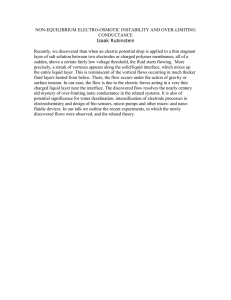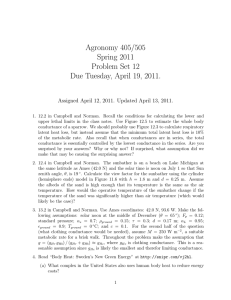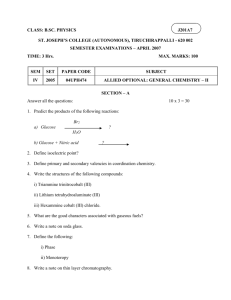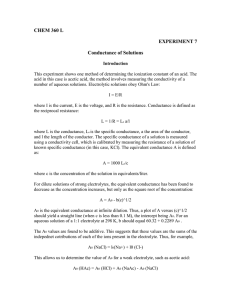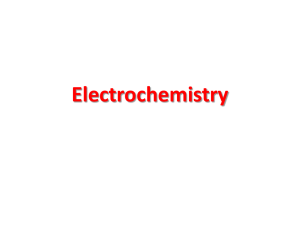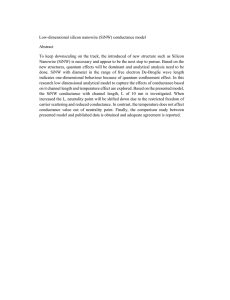Electrolyte Challenge
advertisement
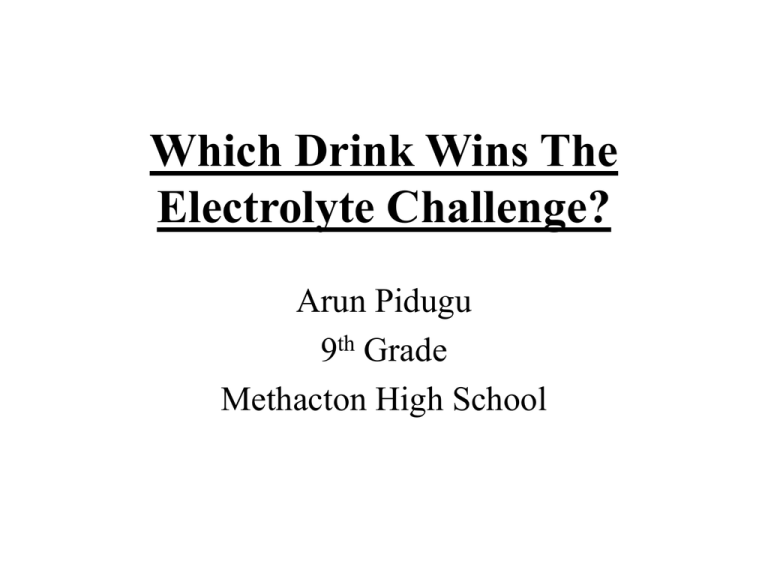
Which Drink Wins The Electrolyte Challenge? Arun Pidugu 9th Grade Methacton High School Research • Electrolytes are salts that will dissociate into ions when dissolved in a liquid. These ions enable the solution to conduct electricity. • All forms of life cannot exist without electrolytes. They are present in the blood stream and other body fluids. Their ability to conduct electricity helps cells send electrical signals to each other. • Electrolytes maintain hydration, blood pH, blood pressure, nerve impulses, and muscle contractions in the body. Some of the important electrolytes that human bodies contain are sodium, potassium, calcium, and magnesium. • Electrolyte levels are maintained by the kidneys and various hormones in the body. Excess electrolytes are filtered out through the kidney. • Electrolyte imbalance can be caused by dehydration, sweating, vomiting, diarrhea, and kidney diseases. It can lead to problems such as muscle spasms, confusion, fatigue, change in blood pressure, seizures. • Since many people consume drinks rich in electrolytes to help them recover from electrolyte loss, I wanted to carry out an experiment to determine the electrolyte levels of the commonly used sports drinks and fruit juices. Research • The electrolyte levels of the solutions were determined by measuring the current with a multimeter and calculating the conductance from the current measured. • During this experiment, a conductance sensor is attached to a multimeter and a 9-volt battery by 2 copper wires. The battery is also connected to the multimeter. When conductance sensor is placed in a solution containing electrolytes, the ions in the solution will close the circuit between the 2 wires and allow electricity to flow between the wires. The electric current will pass through the multimeter, which measures the current using the ammeter portion of the multimeter. • Since electrolytes are charged particles that carry current in the solution, the conductance of the solution depends on the concentration of the electrolytes in the solution. Conductance is proportional to the electrolyte concentration. Problem Question: Which drink provides the most amount of electrolytes? Hypothesis: Out of all the drinks tested in this experiment, Gatorade will contain the highest concentration of electrolytes. Materials • Five 120 ml samples of the following drinks • Gatorade – Orange flavor • Powerade – Orange flavor • Powerade Zero – Lemon lime flavor • Propel Zero – berry flavor • Glaceau Vitamin water - fruit punch flavor • Pedialyte • Orange juice – Simply Orange • Lemonade – Minute Maid • Coconut Water – Vita Coco • Distilled Water • Tap water • 250 ml beaker • Digital Multimeter – P63010 from aquaphoenix education • Copper wire ( 24-gauge ) • Wire cutters • 15 cm ruler • Pen for the plastic tube • 2.5 cm Plastic tube • Handsaw • 9-Volt Battery • 9-Volt battery clip (battery connector) • 2 wires with alligator clips • 236 ml Plastic bowls – 5 • Crystal clear 296 ml sized plastic cups - 60 • Masking tape • Permanent Marker • Paper towels • Lab Notebook Variables • Control Group: Distilled Water • Independent Variable: The different drinks tested in this experiment. • Dependent Variable: The amount of current measured by the multimeter. • Constants: Temperature, Volume of drink measured for each trial, Number of times conductance sensor was rinsed, Voltage of the battery, Thickness of the copper wires, Distance between copper wires, Length of copper wires Procedure 1. Preparation of a conductance sensor 1. Using wire cutters, cut 2 pieces of copper wire so that each wire is 15 cm long. 2. Cut the plastic tube into a 2.5 cm piece using a handsaw. 3. Wrap the 2 pieces of copper wire tightly around opposite ends of the tube, leaving 5 cm of wire free. 4. Make sure that the copper wires are tightly wrapped around the plastic tube and make sure that that the two wires are not touching each other. This is the conductance sensor. 5. Attach the battery clip onto the 9-Volt battery. 6. Attach one of the free copper wires from the conductance sensor to the negative terminal of the battery. 7. Attach the positive terminal of the battery to the red positive terminal of the multimeter using an alligator clip 8. Attach the other copper wire from the conductance sensor to the black negative terminal of the multimeter using an alligator clip. Procedure 2. Setup of the Test Solutions: 1. Rinse 4 plastic bowls with tap water and then with distilled water and dry them immediately with a paper towel. 2. Label one bowl as Tap Water Rinse and add tap water in it. 3. Label three bowls as Rinse 1, Rinse 2, and Rinse 3. Add distilled water into these bowls and use the water from these three bowls to rinse the conductance sensor between different trials. 4. Use 5 different plastic cups for each drink and label them appropriately. 5. Measure 120 ml of each drink five times and pour into the appropriately labeled cup. All the solutions should be kept at room temperature. 3. Conductance Measurement: 1. Set up the multimeter to read direct current (DCA). 2. While measuring the current of the various drinks, make sure that the 2 copper wires never touch each other. 3. Always place the conductance sensor completely immersed and at the same depth in a solution for every reading. 4. The conductance sensor should be removed quickly from the solution to avoid dissolution of the copper wires. 5. Set the multimeter sensitivity level to 20 milliamps(mA) to measure the current of distilled water. 6. Place the conductance sensor in distilled water so that it is completely immersed. Read the current displayed on the multimeter and record it in a lab notebook. 7. If the measurements for distilled water are close to 0.00 mA, then the experimental setup is correct 8. Wipe the sensor dry with a paper towel to remove any drops of distilled water 9. Set the multimeter sensitivity level to 200 milliamps to measure the current for sports drinks and fruit juices. 10. Place the conductance sensor in one of the drinks being tested and measure the current. Note down the reading within 5 seconds after the sensor is placed in the solution. 11. Wipe the sensor dry and then clean it with tap water once and then with distilled water by rinsing it in the 3 distilled water bowls. Afterwards, dry the sensor with a paper towel. 12. Repeat steps 6-8 four more times for the same drink so that a total of five measurements are noted and then calculate the average current. 13. Repeat steps 6-9 for the remaining drinks that need to be tested. Procedure 4. Data Analysis 1. Convert the averages of the readings for each drink from milliamps to amps by dividing by 1,000. 2. Calculate the conductance of each drink by using the equation. G= I V Where, G = conductance, measured in siemens I = current, measured in amperes (amp) V = voltage, measured in volts 3. Convert the conductance in siemens to millisiemens by multiplying by 1,000 4. Since the conductance of a solution is proportional to its electrolyte concentration, the drink with the highest conductance will have the highest concentration of electrolytes. Amount of current measured by multimeter Drinks Tested Current measured by multimeter ( milliamps ) Trial 1 Trial 2 Trial 3 Trial 4 Trial 5 Average Std. Dev. Coconut Water 57.3 55.9 56.3 55.2 54.9 55.92 0.95 Orange Juice 49.3 47.3 49 49.5 50.1 49.04 1.05 Pedialyte 41.6 42.3 41.3 42.8 43.3 42.26 0.83 Vitamin Water 40.7 38.4 39 41.3 38.1 39.5 1.42 Gatorade 25.6 24.5 25.2 24 27.6 25.38 1.39 Powerade Zero 24.9 24.4 26.5 25 25.5 25.26 0.80 Powerade 20.2 18.3 17.8 18.5 18.2 18.6 0.93 Propel Zero 16.2 14 15.8 16 14.7 15.34 0.95 Lemonade 13.2 13.5 13.2 13.3 13.3 13.3 0.12 Tap Water 5.8 5.8 6 5.4 5.5 5.7 0.24 Distilled Water 0.03 0.02 0.02 0.02 0.02 0.022 0.0045 Conductance of Each Drink Drinks Tested Conductance of each drink (millisiemens) Coconut Water 6.21 Orange Juice 5.45 Pedialyte 4.7 Vitamin Water 4.39 Gatorade 2.82 Powerade Zero 2.81 Powerade 2.07 Propel Zero 1.7 Lemonade 1.48 Tap Water 0.63 Conductance (millisiemens) of Various Drinks 7.0 6.5 6.0 Conductance ( millisiemens ) 5.5 5.0 4.5 4.0 3.5 3.0 2.5 2.0 1.5 1.0 0.5 0.0 Coconut Water Orange Juice Pedialyte Vitamin Water Gatorade Powerade Zero Powerade Drinks Tested Propel Zero Lemonade Tap Water Distilled Water Conclusion • At the beginning of this experiment, a hypothesis was formed stating that out of all the drinks tested in this experiment, Gatorade would have the highest concentration of electrolytes. • The results of this experiment showed that coconut water had the highest concentration of electrolytes with a conductance of 6.21 millisiemens, followed by Orange Juice with a conductance of 5.45 millisiemens, Pedialyte with 4.7 millisiemens, Vitamin Water with 4.39 millisiemens, Gatorade with 2.82 millisiemens, Powerade Zero with 2.81 millisiemens, Powerade with 2.07 millisiemens, Propel Zero with 1.7 millisiemens, Lemonade with 1.48 millisiemens, and tap water which had the lowest electrolyte concentration with a conductance of 0.63 millisiemens. • This data shows that the hypothesis of this experiment was proven incorrect since Gatorade only had the fifth highest electrolyte concentration with a conductance of 2.82 millisiemens, compared to coconut water’s conductance of 6.21 millisiemens. Possible Errors • When the sensor is placed in the drink, electrolysis could occur because of the electrical current, which causes gas bubbles to collect on the copper wire, reducing it’s surface area which in turn could decrease the readings. • Another possible error is that the battery can loose a small amount of voltage over time. To make sure that there was no error in the readings, the battery was changed halfway through the experiment and the voltage of the battery was measured periodically with the voltmeter portion of the multimeter. Future Ideas • If this experiment were to be repeated in the future, freshly squeezed fruit juices would also be tested determine which one has the highest electrolyte concentration and also how they compare with the electrolyte concentrations of the store brought fruit juices and sports drinks. Real World Application • Knowing the drinks which have high concentration of electrolytes will help people suffering from problems such as kidney diseases or dehydration pick a drink they like that will replenish their electrolytes effectively. • In underdeveloped tropical countries where sports drinks are either unavailable or expensive, coconut water can be used to replace electrolytes. • Also, since coconut water has a higher electrolyte concentrations than many sports drinks, professional sports teams can also incorporate this drink during strenuous activities along with the sports drinks that they already use.
